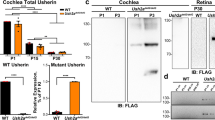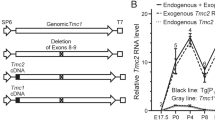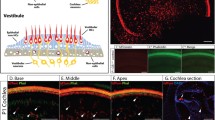Abstract
The Tmhs gene codes for a tetraspan transmembrane protein that is expressed in hair cell stereocilia. We previously showed that a spontaneous missense mutation of Tmhs underlies deafness and vestibular dysfunction in the hurry-scurry (hscy) mouse. Subsequently, mutations in the human TMHS gene were shown to be responsible for DFNB67, an autosomal recessive nonsyndromic deafness locus. Here we describe a genetically engineered null mutation of the mouse Tmhs gene (Tmhs tm1Kjn) and show that its phenotype is identical to that of the hscy missense mutation, confirming the deleterious nature of the hscy cysteine-to-phenylalanine substitution. In the targeted null allele, the Tmhs promoter drives expression of a lacZ reporter gene. Visualization of β-galactosidase activity in Tmhs tm1Kjn heterozygous mice indicates that Tmhs is highly expressed in the cochlear and vestibular hair cells of the inner ear. Expression is first detectable at E15.5, peaks around P0, decreases slightly at P6, and is absent by P15, a duration that supports the involvement of Tmhs in stereocilia development. Tmhs reporter gene expression also was detected in several cranial and cervical sensory ganglia, but not in the vestibular or spiral ganglia. We also describe a new nontargeted mutation of the Tmhs gene, hscy-2J, that causes abnormal splicing from a cryptic splice site within exon 2 and is predicted to produce a functionally null protein lacking 51 amino acids of the wild-type sequence.






Similar content being viewed by others
References
Adato A, Michel V, Kikkawa Y, Reiners J, Alagramam KN, et al. (2005) Interactions in the network of Usher syndrome type 1 proteins. Hum Mol Genet 14:347–356
Ahmed ZM, Goodyear R, Riazuddin S, Lagziel A, Legan PK, et al. (2006) The tip-link antigen, a protein associated with the transduction complex of sensory hair cells, is protocadherin-15. J Neurosci 26:7022–7034
Anderson DJ, Groves A, Lo L, Ma Q, Rao M, et al. (1997) Cell lineage determination and the control of neuronal identity in the neural crest. Cold Spring Harb Symp Quant Biol 62:493–504
Anniko M (1983) Postnatal maturation of cochlear sensory hairs in the mouse. Anat Embryol (Berl) 166:355–368
Barbaric I, Wells S, Russ A, Dear TN (2007) Spectrum of ENU-induced mutations in phenotype-driven and gene-driven screens in the mouse. Environ Mol Mutagen 48:124–142
Belyantseva IA, Boger ET, Friedman TB (2003) Myosin XVa localizes to the tips of inner ear sensory cell stereocilia and is essential for staircase formation of the hair bundle. Proc Natl Acad Sci U S A 100:13958–13963
Beyer LA, Odeh H, Probst FJ, Lambert EH, Dolan DF, et al. (2000) Hair cells in the inner ear of the pirouette and shaker 2 mutant mice. J Neurocytol 29:227–240
Boeda B, El-Amraoui A, Bahloul A, Goodyear R, Daviet L, et al. (2002) Myosin VIIa, harmonin and cadherin 23, three Usher I gene products that cooperate to shape the sensory hair cell bundle. EMBO J 21:6689–6699
Bradley KJ, Cavaco BM, Bowl MR, Harding B, Young A, et al. (2005) Utilisation of a cryptic non-canonical donor splice site of the gene encoding PARAFIBROMIN is associated with familial isolated primary hyperparathyroidism. J Med Genet 42:e51
Bruggeman LA, Martinka S, Simske JS (2007) Expression of TM4SF10, a Claudin/EMP/PMP22 family cell junction protein, during mouse kidney development and podocyte differentiation. Dev Dyn 236:596–605
Burset M, Seledtsov IA, Solovyev VV (2001) SpliceDB: database of canonical and non-canonical mammalian splice sites. Nucleic Acids Res 29:255–259
Cordes SP (2001) Molecular genetics of cranial nerve development in mouse. Nat Rev Neurosci 2:611–623
Denman-Johnson K, Forge A (1999) Establishment of hair bundle polarity and orientation in the developing vestibular system of the mouse. J Neurocytol 28:821–835
Farinas I, Jones KR, Tessarollo L, Vigers AJ, Huang E, et al. (2001) Spatial shaping of cochlear innervation by temporally regulated neurotrophin expression. J Neurosci 21:6170–6180
Fritzsch B, Matei VA, Nichols DH, Bermingham N, Jones K, et al. (2005) Atoh1 null mice show directed afferent fiber growth to undifferentiated ear sensory epithelia followed by incomplete fiber retention. Dev Dyn 233:570–583
Fritzsch B, Pauley S, Beisel KW (2006) Cells, molecules and morphogenesis: the making of the vertebrate ear. Brain Res 1091:151–171
Furness DN, Hackney CM (1986) High-resolution scanning-electron microscopy of stereocilia using the osmium-thiocarbohydrazide coating technique. Hear Res 21:243–249
Gagnon LH, Longo-Guess CM, Berryman M, Shin JB, Saylor KW, et al. (2006) The chloride intracellular channel protein CLIC5 is expressed at high levels in hair cell stereocilia and is essential for normal inner ear function. J Neurosci 26:10188–10198
Huang EJ, Liu W, Fritzsch B, Bianchi LM, Reichardt LF, et al. (2001) Brn3a is a transcriptional regulator of soma size, target field innervation and axon pathfinding of inner ear sensory neurons. Development 128:2421–2432
Johnson KR, Gagnon LH, Webb LS, Peters LL, Hawes NL, et al. (2003) Mouse models of USH1C and DFNB18: phenotypic and molecular analyses of two new spontaneous mutations of the Ush1c gene. Hum Mol Genet 12:3075–3086
Kalay E, Li Y, Uzumcu A, Uyguner O, Collin RW, et al. (2006) Mutations in the lipoma HMGIC fusion partner-like 5 (LHFPL5) gene cause autosomal recessive nonsyndromic hearing loss. Hum Mutat 27:633–639
Kearsey J, Petit S, De Oliveira C, Schweighoffer F (2004) A novel four transmembrane spanning protein, CLP24. A hypoxically regulated cell junction protein. Eur J Biochem 271:2584–2592
Kim WY, Fritzsch B, Serls A, Bakel LA, Huang EJ, et al. (2001) NeuroD-null mice are deaf due to a severe loss of the inner ear sensory neurons during development. Development 128:417–426
Kitajiri S, Fukumoto K, Hata M, Sasaki H, Katsuno T, et al. (2004) Radixin deficiency causes deafness associated with progressive degeneration of cochlear stereocilia. J Cell Biol 166:559–570
Lagziel A, Ahmed ZM, Schultz JM, Morell RJ, Belyantseva IA, et al. (2005) Spatiotemporal pattern and isoforms of cadherin 23 in wild type and waltzer mice during inner ear hair cell development. Dev Biol 280:295–306
Longo-Guess CM, Gagnon LH, Cook SA, Wu J, Zheng QY, et al. (2005) A missense mutation in the previously undescribed gene Tmhs underlies deafness in hurry-scurry (hscy) mice. Proc Natl Acad Sci U S A 102:7894–7899
Mar L, Rivkin E, Kim DY, Yu JY, Cordes SP (2005) A genetic screen for mutations that affect cranial nerve development in the mouse. J Neurosci 25:11787–11795
Matei V, Pauley S, Kaing S, Rowitch D, Beisel KW, et al. (2005) Smaller inner ear sensory epithelia in Neurog 1 null mice are related to earlier hair cell cycle exit. Dev Dyn 234:633–650
Mbiene JP, Sans A (1986) Differentiation and maturation of the sensory hair bundles in the fetal and postnatal vestibular receptors of the mouse: a scanning electron microscopy study. J Comp Neurol 254:271–278
Mburu P, Mustapha M, Varela A, Weil D, El-Amraoui A, et al. (2003) Defects in whirlin, a PDZ domain molecule involved in stereocilia elongation, cause deafness in the whirler mouse and families with DFNB31. Nat Genet 34:421–428
Mburu P, Kikkawa Y, Townsend S, Romero R, Yonekawa H, et al. (2006) Whirlin complexes with p55 at the stereocilia tip during hair cell development. Proc Natl Acad Sci U S A 103:10973–10978
McGee J, Goodyear RJ, McMillan DR, Stauffer EA, Holt JR, et al. (2006) The very large G-protein-coupled receptor VLGR1: a component of the ankle link complex required for the normal development of auditory hair bundles. J Neurosci 26:6543–6553
Michel V, Goodyear RJ, Weil D, Marcotti W, Perfettini I, et al. (2005) Cadherin 23 is a component of the transient lateral links in the developing hair bundles of cochlear sensory cells. Dev Biol 280:281–294
Nishida Y, Rivolta MN, Holley MC (1998) Timed markers for the differentiation of the cuticular plate and stereocilia in hair cells from the mouse inner ear. J Comp Neurol 395:18–28
Oberdick J, Wallace J, Lewin A, Smeyne R (1994) Transgenic expression to monitor dynamic organization of neuronal development: use of the Escherichia coli lacZ gene product, beta-galactosidase. Neuroprotocols 5:54–62
Rzadzinska AK, Derr A, Kachar B, Noben-Trauth K (2005) Sustained cadherin 23 expression in young and adult cochlea of normal and hearing-impaired mice. Hear Res 208:114–121
Self T, Mahony M, Fleming J, Walsh J, Brown SD, et al. (1998) Shaker-1 mutations reveal roles for myosin VIIA in both development and function of cochlear hair cells. Development 125:557–566
Self T, Sobe T, Copeland NG, Jenkins NA, Avraham KB, et al. (1999) Role of myosin VI in the differentiation of cochlear hair cells. Dev Biol 214:331–341
Shabbir MI, Ahmed ZM, Khan SY, Riazuddin S, Waryah AM, et al. (2006) Mutations of human TMHS cause recessively inherited nonsyndromic hearing loss. J Med Genet 43:634–640
Siemens J, Lillo C, Dumont RA, Reynolds A, Williams DS, et al. (2004) Cadherin 23 is a component of the tip link in hair-cell stereocilia. Nature 428:950–955
Simske JS, Koppen M, Sims P, Hodgkin J, Yonkof A, et al. (2003) The cell junction protein VAB-9 regulates adhesion and epidermal morphology in C. elegans. Nat Cell Biol 5:619–625
van Wijk E, van der Zwaag B, Peters T, Zimmerman U, Te Brinke H, et al. (2006) The DFNB31 gene product whirlin connects to the Usher protein network in the cochlea and retina by direct association with USH2A and VLGR1. Hum Mol Genet 15:751–765
Zheng QY, Johnson KR, Erway LC (1999) Assessment of hearing in 80 inbred strains of mice by ABR threshold analyses. Hear Res 130:94–107
Zheng L, Sekerkova G, Vranich K, Tilney LG, Mugnaini E, et al. (2000) The deaf jerker mouse has a mutation in the gene encoding the espin actin-bundling proteins of hair cell stereocilia and lacks espins. Cell 102:377–385
Zine A, Romand R (1996) Development of the auditory receptors of the rat: a SEM study. Brain Res 721:49–58
Acknowledgments
The authors thank the following personnel of the Jackson Laboratory for their contributions to this article: Patsy Nishina and David Bergstrom for helpful comments on the manuscript, Sandra Gray for mouse colony management, Heping Yu for ABR technical assistance, Peter Finger for SEM assistance, Heather Carlisle for design and assembly of the gene-targeting construct, and personnel of the Cell Biology and Microinjection Services for generating the B6.129-Tmhs tm1Kjnmice. They also thank the personnel of the Neuroscience Mutagenesis Facility and the Fine Mapping Service for the initial phenotyping and mapping of the nmf430 (Tmhs hscy-2J) mutation. This work was supported by National Institutes of Health (NIH) Grants DC004301, RR01183, and DC005590 (BF). The Jackson Laboratory institutional shared services are supported by NIH Grant CA34196.
Author information
Authors and Affiliations
Corresponding author
Rights and permissions
About this article
Cite this article
Longo-Guess, C.M., Gagnon, L.H., Fritzsch, B. et al. Targeted knockout and lacZ reporter expression of the mouse Tmhs deafness gene and characterization of the hscy-2J mutation. Mamm Genome 18, 646–656 (2007). https://doi.org/10.1007/s00335-007-9049-x
Received:
Accepted:
Published:
Issue Date:
DOI: https://doi.org/10.1007/s00335-007-9049-x




